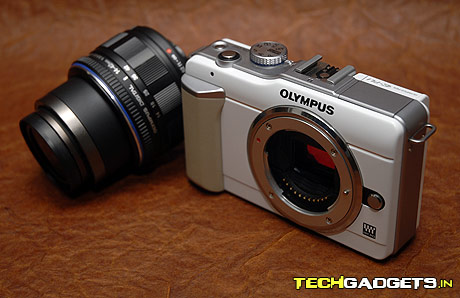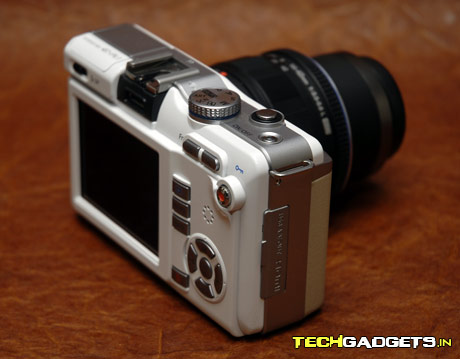
All sorts of thoughts are interrupting our review of the Olympus Pen E-PL1 camera. Nicephore Niepce, without two thoughts, nailed bags of appreciation for using a sliding wooden box camera to capture the first photography way back in 1814. From a simple one megapixel moment capturer to a heavy 14 megapixel one, cameras have witnessed a significant evolvement over the years. With preferences changing like a blue streak, Olympus doesn’t mind endeavoring to entice photography aficionados. The half-frame cameras crafted by this smart wit fell light on both the weight and size of the Olympus Pen. The Pen was a compact amalgam of innovative ideas that plunged into the half-frame upsurge of the 1960s and 1970s.
After creating a whirlwind in the digital world with the E-P1 Micro Four Thirds interchangeable lens camera, Olympus made headlines once again with its, yet another, attractive digital offering. Yes, we couldn’t nod to the left or right when the E-PL1 asked us to review it. So read on as we divulge in this canvass as what captured our hearts and what made us raise our brows.
This 12.3 megapixel camera popped out of a big equilateral box while a rechargeable Li-ion battery, battery charger, and lens dozed composedly there. As first impression is always the last impression, the Olympus Pen E-PL1 didn’t dash our hopes with its mannerly looks. The handy device sports a sedate yet stylish chassis which made us crave for some luminosity without any hemming and hawing. Though slightly paradoxical to vivacious, the company played a game and dabbed it in different hues of black, white and champagne gold, ensuring that your taste for unique shades stays alive. Scaling at 4/3-inch, the good-looking camera now avoids the need to piggyback those heavy DSLR cameras around with its compact size featuring all the essential attributes found on a huge professional camera. Olympus fetches credit for nurturing your photography enthusiasm with a commendable blend of lightweight body and impressive features. To your advantage, if anyone thinks of sliding it in their bag without your ‘go-ahead’, its non fingerprint-resistant 2.7-inch HyperCrystal LCD display with Anti-Reflective coating could successfully clue in about the guilty. With a weight of just 133g, the device is quite portable though not compact enough to fit into a pair of regular denims.
The little brother of E-P2 quite impressed with the same sensor and most of its kin’s capabilities. But if you are feeling little silly for having forked out even that ‘save for the rainy day’ amount, then remember the big brother still embraces more professional details like dials for shuffling through manual settings and better image stabilization. The addition of a flash, which conceals itself pretty nicely on the top, adds insult to injury. A symbol with the word ‘up’ just above the monitor on the back leaves you with a sliding mechanical switch to open that cool built-in pop-up flash for better pictures. It offers a range of flash synchronization modes, an X-sync speed of 1/160 s/ 1/2000s, the ability to dial-in compensation of +/- 3 EV, and can also be employed to trigger an off camera flash (either the FL-50R or FL-36R). The little pop-up flash for sure left us grooving on it, we just wish that Olympus had also added it to the E-P2. Just next to it eases off the hot shoe and accessory port combo with the cover ripped out. Aesthetically, the camera surpasses its two other siblings with decent and build quality more in line with the price tag attached to it. Unfortunately, an optical viewfinder makes a miss, fueling up the competition with positive and negative traits allocated throughout.
The bottom door for the SDHC card and battery is solid, and the concealed rubber flap on the side to expose USB and HDMI plugs takes a nap for connectivity options. The front panel has the word ‘Olympus’ scribbled on it with black color bold letters and hogs most of the space with lens. Besides, it offers you a very firm thumb support around the movie REC button to hold while clicking those pictures or recording videos, while the top panel gives you a decent flash port, allocated just next to the built-in one, to attach your own flash. A new mode dial, well placed for easy thumb activation, sports features like manual, shutter speed, auto-focus, program, scene, art, and iAuto to enhance one’s capturing experience. On the other hand, the shutter release button appeared quite sober to us. Adjoining it lies down a very small power button, lit with a blue LED inside. Though easy to slip by, two holes for the monaural microphone were also spotted just in front of the hot shoe.

On Olympus E-PL1’s rear part, the LCD panel is the same HyperCrystal design with 230,000-pixel resolution. In the wake, the accessory port, and the Zoom-in and Zoom-out buttons add some grace to the digital piece. The Movie Record button is marked with a traditional red dot, and protected on the lower left quadrant by a raised ridge that serves as the ‘thumb grip’. Then there are Playback, Menu, and Info buttons, followed by the trashcan button to delete those early morning pictures. Next, the four-way navigator has also been designed with the exception of the AF button that occupies the left arrow position, and the Drive mode button in the down arrow position. Unfortunately, Olympus didn’t place any dial for quick aperture or shutter speed changes when in Aperture or Shutter priority modes, or Manual.
For those not so technically advanced in exploring its heavy features, a new Live Guide interface moves in to assist. With this new guide equipped intelligently, we could easily adjust the brightness, hue, background defocusing, and certain other image parameters. Its dedicated movie mode button let us record movies with 720p HD at a moment’s notice, while i-Enhence Picture mode (originally released on the E-P2) mesmerized us with exceptional clarity and heightened realism. One noticeable factor that caught our attention was that even if the mode dial wasn’t set to Movie mode, a quick press of this button allowed us to switch seamlessly back and forth between still image and movie shooting. Apart from this, on selecting ‘iAuto’ on the mode dial, i-Enhence was discovered getting adjusted as the default Picture mode for a heightened sense of realism in the final image. In iAuto mode, the camera automatically analyzes the scene and selects the appropriate shooting mode (Portrait/ Landscape/ Macro/ Sports/ Night Scene/ Night Scene Portrait) according to the primary subject.
Consequentially, recording was supported at a widescreen aspect ratio of 16:9 (1280 x 720), as well as a standard aspect ratio of 4:3 (640 x 480, 30fps). We also appreciated Olympus’s innovative idea of integrating the camera with a much larger sensor than most handheld camcorders. While exploring, defocusing the background by controlling aperture and taking advantage of all the other creative benefits of interchangeable-lens photography was also seen possible. Well, if shutter bugs feel like shooting movies, its built-in electronic image stabilization can be put to use. Interestingly, Manual controls and Art Filters also revealed great usage possibilities when we tried our hand at shooting movies. Audio was further recorded in linear PCM format which is an uncompressed digital format noted for its super sound quality. On the portability front, even though the E-PL1 features a built-in image stabilization system and GN10 flash, it gave us a look of being more compact than conventional SLR cameras. For those eager to enhance their photographic creativity, six Art Filters, including new Gentle Sepia, have been packed in. With its Pop Art, we could see images turning stronger and more vivid with a pop-art feel, while Grainy Film imparted a dramatic feel to images by recreating the classic grainy look and tonality of black & white photography. The Pin Hole feature helped us adjust the color and brightness at the periphery, while Diorama overawed us by revealing the look of a miniature diorama. We could also see Soft Focus generating a unique image quality.
We also liked the camera’s simple, intuitive control layout with large buttons which made it super-easy for us to operate a technical interchangeable lens camera like this. Then on, we appreciated its Continuous-Tracking AF function that automatically tracks subject movement within the frame. Impressively, we could also detect up to 8 faces and optimize focus, thanks to its advanced Face detection technology. Olympus further empowered its digital camera with a dedicated one-touch Enlarge button. When pressed once, it represents a broadened view and on further hitting the button, a complete full-frame field of view is achieved. Apart from this, we were able to enjoy blur free photographs, undeterred by our shimmy hands, with a top-notch image stabilization system.
To sum it up, the Olympus Pen E-PL1 camera embodies powerful features that can be espied in any DSLR camera or HD camcorder. If you live by ‘looks don’t matter but the work does’ then this one with its nostalgic looks can be a great choice. Apart from giving you a reason to tilt your head high, the latest offering from Olympus’s portfolio of great cameras can be a perfect device to capture those special moments spent at a holiday or just everyday life. Overlooking its yesteryear’s looks for a moment and focusing on its capability to subsume advanced features in a compact body, the camera triumphs in winning an impressive 9 out of 10 from us. Shutter bugs will have to shell out Rs. 29,999 to capture pictures from the Olympus Pen E-PL1.




